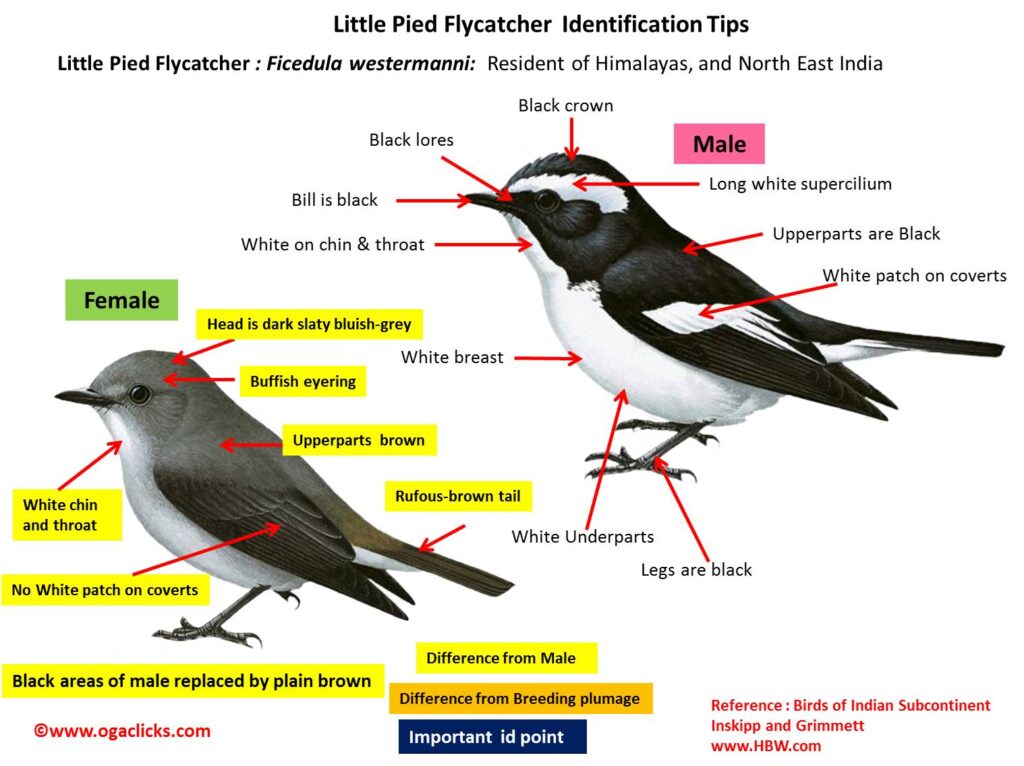
Little Pied Flycatcher Ficedula westermanni
Etymology:
- Ficedula : Latin word ficedula –small fig-eating bird
- Westermanni : Named after Dutch zoologist Gerard Fredrick Westermann (1807–1890)
-
-
- Collini : Johan Albert Collin (1875-1952) Finnish engineer, ornithologist
-
-
-
- Australorientis : Latin word for australis -southern ; oriens, orientis– east
-
Vernacular Names : Cachar: Dao-put-ti-ti, Lepcha: Tuni-ti-ti, Mar: Kavdya Mashimar
Subspecies :
- w. collini – Central Himalayas from North India (Himachal Pradesh) to Nepal; non-breeding in foothills and North East India. {brown forehead and lores, becoming grey-brown on rest of head to back (or olive-brown on crown), with dull brownish-rufous rump and base of tail, sometimes a brownish wash on throat and upper breast}
- w. australorientis – Sikkim and North East India (Arunachal Pradesh, Assam South to Meghalaya), Nepal {crown to nape mouse-grey, becoming pale brown on back, and rump to edges of tail base reddish or rich rufous-brown}
Distribution in India:
- w. collini – Central Himalayas from North India (Himachal Pradesh) to Nepal; non-breeding in foothills and North East India.
- w. australorientis – Sikkim and North East India (Arunachal Pradesh, Assam South to Meghalaya
Description: Size of 10–11 cm; wt. of 7–8 g. It is a small, large-headed flycatcher. The male has long white supercilium from over lores, broadening behind eye and curving behind ear-coverts. The top and side of head and upperparts, including upperwing and tail are black. It has a broad white patch on inner greater coverts and edges of tertials, white bases of outer tail feathers. The throat and underparts are white, fine dark streaks on breast side and flanks. The iris is dark brown. The bill and legs are black. The female of nominate race has head to mantle as dark slaty bluish-grey, warmer brown on rump, dull rufous-brown on uppertail-coverts, and russet-brown edges at base of tail feathers. The greater coverts are tipped pale forming a narrow wingbar. It is dull whitish below, with buffish-brown or brownish-grey feather edges on breast and flanks. The juvenile is heavily spotted with buff on head and upperparts, with buff tips of median and greater upperwing-coverts, dark bars or scaling on breast and flanks; juvenile male has white panel on greater coverts and tertials , juvenile female has rufous-brown rump and tail base. Races differ only in respect of females, which vary in colour of head, back, rump, uppertail-coverts and edges of tail base: collini has brown forehead and lores, becoming grey-brown on rest of head to back or olive-brown on crown, with dull brownish-rufous rump and base of tail, sometimes a brownish wash on throat and upper breast; australorientis has crown to nape mouse-grey, becoming pale brown on back, and rump to edges of tail base are reddish or rich rufous-brown.
Habitat: It breeds in broadleaf deciduous and evergreen forests.In breeding season it is found between 1200 m and 3000 m. In wintering it is at at lower levels up to 1800 m in similar habitat and more open woodland, including orchards and edges of cultivation.
Food habits: It eats small invertebrates and larvae, flies , beetles and weevils ,spiders and lepidopteran caterpillars. It is found usually in pairs in breeding season; otherwise, solitary or in roving mixed-species flocks. It is conspicuous, and actively forages through middle to upper canopy, seemingly always on the move from branch to branch and from tree to tree. It picks or gleans insects from among foliage, branches and tree trunks, occasionally low down at forest edge. It also pursues insects in short flight. It also perches prominently on roadside wires.
Breeding habits: They breed in Mar to Aug. The nest is built by both sexes. The nest is a cup of moss, plant fibres, rootlets, dry sedges, animal hair and fungal hyphae, placed in epiphytic fern stems, orchid clumps or creepers, or on ground among stones, tree roots or under boulders on bank or slope. They lay a clutch of 2-3 eggs. The incubation of eggs and care of nestlings done by both sexes.